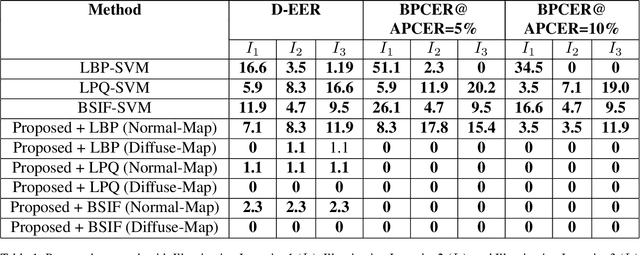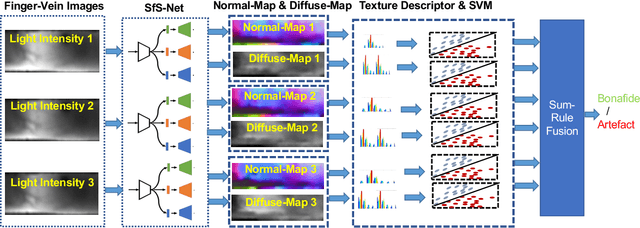Detecting Finger-Vein Presentation Attacks Using 3D Shape & Diffuse Reflectance Decomposition
Paper and Code
Dec 03, 2019



Despite the high biometric performance, finger-vein recognition systems are vulnerable to presentation attacks (aka., spoofing attacks). In this paper, we present a new and robust approach for detecting presentation attacks on finger-vein biometric systems exploiting the 3D Shape (normal-map) and material properties (diffuse-map) of the finger. Observing the normal-map and diffuse-map exhibiting enhanced textural differences in comparison with the original finger-vein image, especially in the presence of varying illumination intensity, we propose to employ textural feature-descriptors on both of them independently. The features are subsequently used to compute a separating hyper-plane using Support Vector Machine (SVM) classifiers for the features computed from normal-maps and diffuse-maps independently. Given the scores from each classifier for normal-map and diffuse-map, we propose sum-rule based score level fusion to make detection of such presentation attack more robust. To this end, we construct a new database of finger-vein images acquired using a custom capture device with three inbuilt illuminations and validate the applicability of the proposed approach. The newly collected database consists of 936 images, which corresponds to 468 bona fide images and 468 artefact images. We establish the superiority of the proposed approach by benchmarking it with classical textural feature-descriptor applied directly on finger-vein images. The proposed approach outperforms the classical approaches by providing the Attack Presentation Classification Error Rate (APCER) & Bona fide Presentation Classification Error Rate (BPCER) of 0% compared to comparable traditional methods.
 Add to Chrome
Add to Chrome Add to Firefox
Add to Firefox Add to Edge
Add to Edge